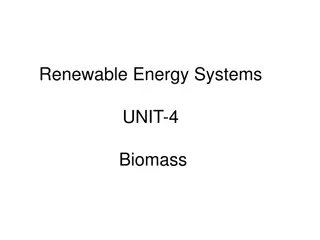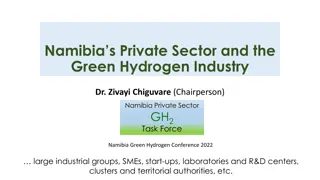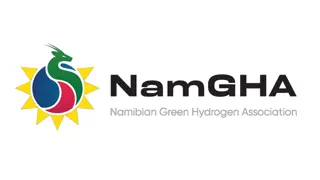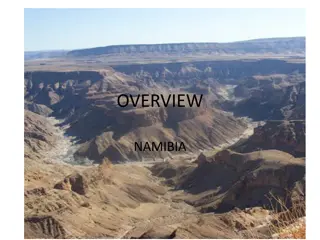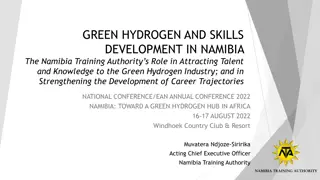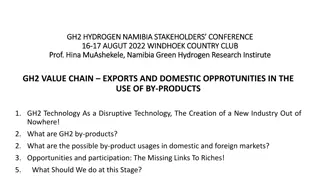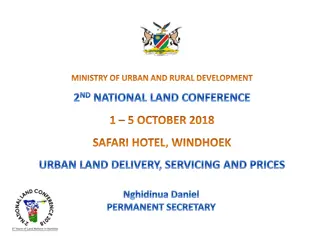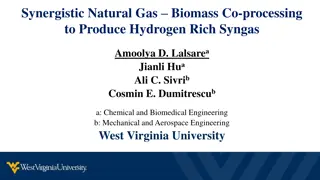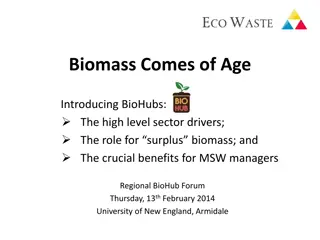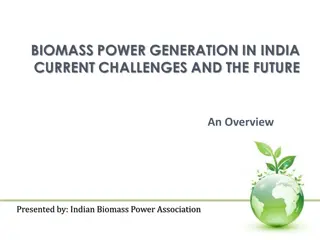Maximizing Biomass Sector Growth in Namibia through Thermal Processing Technologies
The Namibia Biomass Research Symposium 2023 emphasizes the potential of the Namibian biomass sector in igniting growth through thermal processing of encroacher bush-based biomass. With vast untapped biomass stocks and a focus on thermochemical and direct combustion technologies, the symposium highlights opportunities for job creation, cleaner environments, and sustainable control of bush encroachment. Recommendations include diversifying biomass value chains and exploring torrefaction for pretreatment in combustion processes.
Download Presentation

Please find below an Image/Link to download the presentation.
The content on the website is provided AS IS for your information and personal use only. It may not be sold, licensed, or shared on other websites without obtaining consent from the author.If you encounter any issues during the download, it is possible that the publisher has removed the file from their server.
You are allowed to download the files provided on this website for personal or commercial use, subject to the condition that they are used lawfully. All files are the property of their respective owners.
The content on the website is provided AS IS for your information and personal use only. It may not be sold, licensed, or shared on other websites without obtaining consent from the author.
E N D
Presentation Transcript
Namibia Biomass Research Symposium 2023 Igniting the Growth of the biomass sector in Namibia The present and future outlook of the Namibian encroacher bush-based biomass thermal processing industry Charles Rashama1*, Progress Kashandula1, Bruce A. Brewer2, Colin Malan Lindeque3 1Namibia Biomass industry Group, 5 von Braun Street, Southern Industrial Area, Windhoek, Namibia. 2Cheetah Conservation Fund, P.O. Box 1755 Otjiwarongo, Namibia. 3Carbon Capital Pty Ltd, 35 Crohn Schanzen Road, Windhoek, Namibia. Gross Barmen Resort Gross Barmen Resort 7 September 2023 7 September 2023 w w w .bioma s s f a ir.com.na
Introduction Introduction Namibian bush encroachment highlights (Peter Heck, 2021) 3-5% per annum growth versus 1% bush usage 30 - 45 million ha of Namibian land encroached 60% commercial and 40% communal land 300 - 450 million tons untapped biomass stocks 1.4 million tpa use in various bush value chains Predominantly charcoal production 650 producers and 6000 workers No.1 exporter in Africa No. 12 global production Current efforts insufficient to control bush encroachment. Additional value chains are possible through biomass thermal processing Fig 1: Biomass Processing Plants Database (IEA, 2023) w w w .bioma s s f a ir.com.na
Thermochemical Technologies Maximize local benefits from encroacher thermal processing Different biomass thermochemical pathways: Conditions & Products (Mishra & Upadyay, 2021) $, Cleaner $, Cleaner environment, environment, Jobs Jobs Opportunities for Namibia Diversify biomass value chain to include new high value product classes Sustainably control bush encroachment at significant scale Heat and Pressure First commercial scale exploitation in Africa - Better returns to early investors Potential for registering project under UNFCC Clean Development Mechanism Diversity in operating conditions, scale of operation hence Capex and Opex requirements. Diverse products hence lower risks exposure. Scope for serving local interests jobs, products, expertise in R & D, etc w w w .bioma s s f a ir.com.na
Direct Combustion Direct Combustion Overview Opportunities in Namibian Mature technology globally being used for power, process heat and heating. (wood, woodchips, pellets, powder, sugar bagasse, forestry residues) A handful of Namibian private sector European industry shifting from direct combustion into producing high value products plants use combustion for thermal mainly due to reduction in incentives. energy generation (Ohorongo Cement, Breweries) Main advantage is that technology has low pretreatment costs. NamPower 40MWe Otjikoto Biomass Cons Health risks associated with domestic firewood use Power plant Development is ongoing Co-firing with low calorific value woodchips 50% of Namibians still rely on wood Transport of low density wood chips fire for cooking and heating in rural Decomposition risk during storage Poor friability areas (National Energy Policy, 2016). Recommendations: Namibia should consider torrefaction as a pretreatment to wood before combustion w w w .bioma s s f a ir.com.na
Pyrolysis (Slow, Intermediate & Fast) Overview Opportunities in Namibia Context Among top 10 charcoal exporters globally. Global priority is on biocrude versus charcoal production. Main advantage is process flexibility towards a broad product selection (Uddin et al, 2018) Scale of operations involved can not stop encroachment. Major challenges in Namibia are Limited local use of product Pollution (smoke and emissions) Labour issues Current charcoal volumes do not significantly help control bush encroachment on national scale Recommendations: Namibia should explore biochemical recoveries from pyrolysis plants Cons If not managed properly has extensive SHE and energy issues (fines, fumes, drying needs) w w w .bioma s s f a ir.com.na
Torrefaction Torrefaction (Mild Pyrolysis) (Mild Pyrolysis) Overview 100 registered patents, 6 different technologies commercialized. 20 companies in operation. More than 60 tech developers globally. IBTC, independence since Jan 2024. (IEA, 2015) Opportunities for Namibia No operating entity in Namibia at the moment. One pilot plant (2010), Nampower feasibility studies (2012) and SteamBioAfrica (2023). Opportunities exist to replace imported coal NamPower, Breweries, Slaughterhouses and Cement and other industries Advantages Wood use in household cooking/braiing can also be replaced Easier shift from coal to biomass Products fit both industrial and home use Recommended Process effluents can be valorized into process heat gases or biochemicals. Subsidies for torrefaction investments or penalties for CO2 emissions to motivate investments (Government). Cons Optimisation to ensure consistent product QC results (R & D institutions) Need for small sized feed increase capex on milling, screening and subsequent pelletizing. Develop product marketing channels (Industrialists) w w w .bioma s s f a ir.com.na
Hydrothermal Liquefaction (HTL) or Hydrothermal Carbonization (HTC) Hydrothermal Liquefaction (HTL) or Hydrothermal Carbonization (HTC) Opportunities for Namibia Overview NUST/UNAM can partner other global research institutions in HTL to build local capacity and enable Namibia grabbing of commercialization opportunities once the breakthroughs are realized. This tech is still at R & D stage with extensive research happening around the globe The desired product is liquid biocrude for subsequent hydrotreating into various fuels and platform chemicals Gases and biochar are byproducts Scope for student exchange programs (Staff development fellowships) Advantages Government scholarships with bonding arrangements at NUST/UNAM. 1) Applicable to wet biomasses hence better energy saving in avoiding drying Potential for regional hub Research Institute, CoEs, CoCs: proximity to the different biomass resources. 2) Comparative LCA studies showed that HTL emits significantly lower GHG than pyrolysis. 3) Diverse products Private sector support through scholarships/bursaries Cons Energy required for high pressure & product recovery w w w .bioma s s f a ir.com.na
Overview: Gasification Overview: Gasification Global Outlook 1980s to date More than 150 operational plants globally (IEA, 2021) More than 50 plants planned or on hold Investments (Europe) shifting from power to liquid fuels. Chemicals and Gas fuel almost constant w w w .bioma s s f a ir.com.na
Gasification: Namibian Opportunities Gasification: Namibian Opportunities Advantages Low risk of failure -A tried and tested technology at global scale (esp with coal) Ready local/regional market for products especially chemicals Technology can take different wood species Product yields profile can be customized Cons The high demand for water in operations Limited products QC monitoring and certification expertise High capital and maintenance costs Limited personnel experience to operate and maintain plant There has been a few attempts to run small gasification plants in Namibia in the past Different extents of success. Namibia could focus on capacity building and water resources to fully exploit gasification w w w .bioma s s f a ir.com.na
Overall Recommendations Overall Recommendations Short Term Combine Charcoal pyrolysis business with biochemical oil production and upgrading (Current Charcoal Producers). Proceed with the Combustion based power plant projects but incorporate provisions for retrofitting torrified products. Accelerate torrefaction project implementation (NamPower). Incentivise torrefaction project implementation (Government) Medium Term Consider investing into water resources to enable full exploitation of the Gasification technology at commercial scale. Build capacity for plant operation, maintenance, supply chain for spares (NUST/UNAM/SMES/Private Sector) Long term Invest in biorefineries (Biomass Industrial Parks) Feedstocks, Biofuels, Biochemicals, Biofertiliswers, etc (N-BiG) Invest in Research and Development Research Centres, CoC, CoEs, etc (NUST/UNAM) w w w .bioma s s f a ir.com.na
T h a n k Y o u Colin Charles Progress Bruce Acknowledging w w w .bioma s s f a ir.com.na





